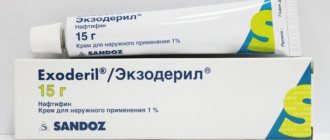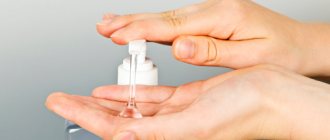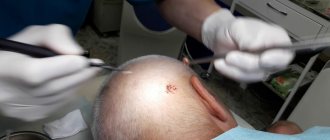1.General information
Dermatophytosis is a large group of infectious skin diseases caused by mold fungal cultures called dermatophytes. Translated from ancient Greek, “dermatophyte” means “skin vegetation,” which apparently reflected the ideas of ancient healers about the essence of this disease. Today, dermatophytic mycoses are a very serious problem: not presenting a direct threat to life in most cases, such infections sharply reduce its quality, causing significant physiological and psychological discomfort, and are characterized by high therapeutic resistance (resistance), chronic and persistent (persistent) course , a tendency to relapse, since immunity to dermatophytes is not developed and repeated infection with the same pathogen is possible.
It is extremely difficult to estimate the exact prevalence of dermatophytosis: apparently, not all cases are included in official medical statistics; This is especially true for mycoses of low-symptomatic or subclinical severity, in which, nevertheless, the infected person remains highly contagious.
Almost all special epidemiological studies reveal a trend towards an increase in incidence. Today, at least a fifth of humanity is infected with one or another dermatophyte fungi.
The idea of dermatophytosis as a predominantly childhood disease is erroneous: in fact, the risk of infection and the clinical picture do not depend on age.
A must read! Help with treatment and hospitalization!
Prevention
Prevention of fungal infections consists of observing the following principles:
- Keep your skin clean and dry.
- Change your underwear, clothes and socks regularly.
- All personal items must be individual.
- Treat your skin with disinfectants after water treatments in a bathhouse, swimming pool, visiting the gym and other public places.
- Dry your feet after water treatments or visiting the gym.
- Avoid walking barefoot on beaches and public places.
- Carefully inspect the fur of your pets and if you suspect lichen, contact a specialist.
- Before using gym items, make sure they are clean.
2. Reasons
Dermatophyte fungi, according to mycologists, originated from soil saprophytes, which in the process of evolution developed the ability to decompose and metabolize keratin - the amino acid “building material” of skin, nails and hair. Depending on what is the main habitat for a given crop - soil, animal skin or human skin and hair - three groups of dermatophytes are distinguished: geophilic, zoophilic and anthropophilic, respectively. Representatives of all three groups are pathogenic or opportunistic; The biggest problem is, as you might guess, anthropophilic dermatophytes, which can cause real epidemics. However, two other types of dermatophytosis do not lose their medical and social significance: epidemic outbreaks of geo- and zoophilic mycoses are periodically observed in rural areas or in connection with the next boom in fashion for pets.
Of the forty-three species of dermatophytic fungi known today, thirty pose a danger to humans, and in each case, dermatophytosis occurs with certain clinical nuances.
Risk factors include failure to comply with hygiene, skin and hair care rules; the presence of certain diseases (especially vascular pathology); long-term use of hormonal drugs; improperly selected shoes and clothing that cause sweating; microcracks and microtraumas on the skin; any weakening of the immune system (exhaustion, previous surgery, severe bacterial or viral infections, hypothermia, etc.).
Visit our Dermatology page
How to treat in an advanced stage
There are several methods of such therapy, which are briefly described below.
Hardware processing
Hardware processing is safe since no cutting tools are used. This treatment of nails and foot skin is especially recommended for people with diabetes, where any scratch can be fatal. Plus, only disinfectant solutions and disposable instruments are used, so the pathogen will not be transmitted to other clients or the technician himself. In combination with fungicidal drugs, hardware treatment of nails increases the effectiveness of treatment by 86%.
Ozone therapy
Ozone therapy is not the main method of treating dermatophytosis, but it significantly improves the course of the disease. Ozone is very unstable, so it can easily penetrate the cell wall of fungi, destroying them and preventing their spread. Therefore, it is often used to remove mold and disinfect swimming pools.
Ozone also improves the access of oxygen to tissues, and this promotes rapid regeneration of affected areas. But the method has a number of contraindications, so before going to a dermatology clinic or cosmetology center, you should consult with your doctor.
Laser method
The effectiveness of laser treatment has been proven when affecting fungal cultures in a nutrient medium. A high-intensity laser turned out to be most effective in suppressing the growth of fungal colonies. This treatment works well and improves the prognosis in the treatment of onychomycosis.
Typically, topical therapy cannot penetrate deep into and under the nail plate. But the laser can penetrate deep layers and inhibit the growth of fungi. An undoubted advantage is that this method has virtually no contraindications and does not cause any discomfort.
3. Symptoms and diagnosis
The common, most typical symptoms for the entire group of dermatophytoses are round and gradually expanding foci of inflammation and/or ulceration, caused by the influence of keratinolytic and other enzymes that destroy proteins (elastin, collagen, etc.), which, in turn, are produced by dermatophytes in the process of life. . As a rule, the aggressive activity of the dermatophyte is limited to the surface layer of the skin, however, under unfavorable internal conditions in the affected organism (absence or weakening of protective factors), deeper and more severe mycoses are possible.
Localization can be very different: head, feet, nails, joint bends, inguinal folds, and many others.
As shown above, the clinical presentation varies depending on the specific pathogen. For example, hair in lesions may become brittle or fall out altogether; inflammation may be more or less pronounced; with one dermatophyte infection, dry crusts predominate, with another, peeling predominates, with a third, suppuration occurs, etc. When nails are affected, yellow-white spots appear in them, and the nail plate usually loses its transparency and thickens. Dermatophytic mycosis localized on the feet and hands often manifests itself as hyperkeratosis (roughening, keratinization) with the formation of painful cracks.
The diagnosis is established and confirmed by laboratory microscopic examination of biomaterial taken from the affected areas. If necessary, a Wood's fluorescent lamp is used, and additional tests are carried out aimed at identifying the characteristics of the pathogenic fungus and its most vulnerable characteristics.
About our clinic Chistye Prudy metro station Medintercom page!
At-risk groups
Men are more susceptible to dermatophytosis inguinalis than women. The following also increase the risk of infection:
- history of fungal infections;
- weakened immunity;
- disruption of the endocrine and digestive systems;
- stressful conditions;
- climatic conditions (high humidity and air temperature);
- close-fitting clothing;
- presence of chronic diseases;
- increased sweating (hyperhidrosis);
- frequent visits to public baths and saunas;
- obesity;
- genetic predisposition.
4.Treatment
To date, a wide range of antifungal drugs – antimycotics – has been developed and successfully used.
The course of treatment, as a rule, is quite long, includes additional aseptic measures and requires from the patient not only patience, but also a good level of compliance, i.e. therapeutic consent, therapeutic alliance with the doctor, including understanding of etiopathogenetic mechanisms and literal compliance with the instructions received.
It should be recalled that even after complete eradication of the dermatophyte fungus, immunity to it is not formed, but with inadequate therapy or self-medication, such an invasion easily turns into a latent, low-symptomatic or asymptomatic form, so that in the future, with the slightest weakening of the body’s protective resources, it can become active again.
Dermatophytosis corpus refers to superficial skin infections of the trunk and extremities and is found throughout the world, but is most common in tropical countries. T. interdigitale (T. mentagrophytes) is the second most common pathogen in the world [1]. Infection occurs through direct contact from person to person, or from animal to person, or through contact with soil. Recently, we have repeatedly examined patients with common dermatophytosis and lesions of the genital organs. Genital dermatophytosis is less common compared to athlete's foot inguinal [2 – 5]. Several cases of genital dermatophytosis [6] in combination with inguinal athlete's foot, onychomycosis, and athlete's foot and hand [7,8] have been described in the literature. In one case, the suspected source of infection was an animal [9]. The article describes 7 patients with genital dermatophytosis, with a possible sexual route of infection.
Patients and methods
In our clinic, 7 patients (2 women and 5 men, aged 18 to 55 years) with genital dermatophytosis that arose after sexual contact in Southeast Asia were examined from March to July 2014. 5 patients were treated at Trieml Hospital and 2 at the University Hospital of Zurich. Diagnostics included microscopy, cultural examination and DNA analysis. Informed consent was obtained from each patient.
Samples for research were obtained by scraping from the affected area. Bacterioscopic examination was carried out by staining with 5% sodium dodecyl sulfate in Congo red solution. The culture was grown on a selective agarose nutrient medium (Selektivagar für pathogene Pilze 139e-20p, heipha Dr Müller GmbH, Germany) with the addition of cycloheximide and chloramphenicol for 4 weeks at a temperature of 25. DNA analysis was carried out by sequencing using a genomic DNA kit (Nexttec, Germany). The transcribed region was amplified using primers ITSI and ITS4. The DNA analysis results obtained were comparable with the available database.
results
Our first patient was an 18-year-old woman of Caucasian origin living in Japan with no history of skin diseases. She had repeated unprotected sex with a Caucasian man in Thailand. In addition, she constantly shaves her pubic hair. A week after her first sexual intercourse, she developed red, scaly rashes on the skin of her genitals. Her sexual partner had also previously reported similar symptoms. She used Clotrimazole cream. However, after 2 weeks she noted the spread of the rash and the appearance of headache and malaise. An increase in erythematous plaques in size and the appearance of follicular pustules on the labia and pubis were noted (Fig. 1). There was no regional lymphadenopathy. The blood test showed leukocytosis up to 14x109/l and elevated C-reactive protein (30.8 mg/l). Microscopy revealed fungal hyphae, and culture identified T. interdigitale. Terbinafine was prescribed daily at a dose of 250 mg, and if a secondary bacterial infection was suspected, Amoxiclav was prescribed. Due to severe pain, she was hospitalized. After two days the inflammation subsided. Ulcerative nodules with serous-purulent contents formed on the skin in the area of the symphysis pubis (Fig. 2). Terbinafine was replaced by itraconazole 100 mg 3 times a day, and prednisolone 50 mg was administered orally. Due to severe pain, the patient was hospitalized for 14 days. After 6 weeks of itraconazole and 3 weeks of prednisolone, the rash resolved with severe scarring.
Between March and June, we examined an additional 6 patients (5 men and 1 woman) with genital dermatophytosis. These patients reported having had sexual intercourse 1 to 2 weeks previously in Southeast Asia. Four men had sex with local prostitutes. All patients used condoms and did not use lubricant.
Before consultation in our clinic, patients independently used topical glucocorticosteroids, antibiotics and antimycotics. All patients had similar symptoms: there were sharply circumscribed erythematous plaques with scales on the skin of the groin area, labia majora and proximal shaft of the penis, and in one patient the rash was on the skin of the scrotum (Fig. 3). In two patients, the rashes were also located on the skin of the buttocks and neck. One patient had a rash on the upper lip, and another had a rash on the forearm. Follicular pustules developed in 4 patients, and in 3 patients the inguinal lymph nodes were enlarged. Five patients had no pubic hair. In all patients, the rash first appeared in the genital area and then spread to other areas.
Fungal hyphae were detected by microscopy in all patients, and T. interdigitale was isolated by culture. When compared with the polymorphism studied and published by Heidemann et al. [11], it was revealed that 3 strains corresponded to type III T. interdigitale and 3 strains corresponded to type IV T. interdigitale. It is likely that all strains were originally of zoophilic origin. In three patients, bacterial cultures were negative. Tests for sexually transmitted infections were negative.
All patients were prescribed systemic antifungal drugs. 6 patients were prescribed Terbinafine and one patient was prescribed Itraconazole. Treatment lasted from 2 to 10 weeks (average 5 weeks). Patients initially used topical Ciclopirox cream (3 patients), Clotrimazole cream (2 patients), Terbinafine cream (1 patient), and fusidic acid cream (1 patient), in combination with halomethasone/triclosan and Betadine suppositories. Due to severe inflammation, 3 patients were prescribed treatment with systemic prednisolone for 6–21 days. Three patients received additional systemic antibiotics. 5 patients required pain therapy. Due to severe pain, 2 patients were hospitalized (3 and 14 days, respectively). 5 patients were declared incapacitated for 6–14 days. 4 patients were completely cured.
Discussion
We presented 7 cases of dermatophytosis with damage to the genital organs, after 1 - 2 weeks. after sexual intercourse in Southeast Asia. Previously, a similar case was described in Denmark: during a cultural examination, T. mentagrophytes was isolated and severe inflammation was observed in the same way as in our patients. In addition, there are reports that genital dermatophytosis is more often observed in tropical countries with warm and humid climates, and is accompanied by weeping and maceration of the skin [13 – 14]. This explains the fact that all cases of infection occurred after travel to Southeast Asia. In addition, friction during sexual intercourse further contributes to infection, this is confirmed by a series of studies by Otero et al. [15], as well as Bakare et al. [16], who described similar cases among prostitutes in Spain and Namibia. However, there is currently no information about the occurrence of genital dermatophytosis in Southeast Asia.
Diseases such as diabetes mellitus, atopic dermatitis and the development of immunosuppression, as a rule, contribute to the development of genital dermatophytosis [3 – 5 – 7]. However, no predisposing diseases were found in our patients. Interestingly, 4 patients with severe inflammation reported constantly shaving the pubic area. Shaving leads to disruption of the epidermal barrier, and thus promotes the spread of infection into the dermis [17]. The keratinized material from the destroyed follicles remains in the dermis and serves as a nutrient substrate for the proliferation of fungi. Majocchi granuloma on the legs of women is more often associated with regular shaving [18]. Consequently, constant shaving of the genitals contributes to the spread of the pathogen deeper along the hair structure.
Zoophilic strains of T. interdigitale, isolated from 6 patients, are known to provoke a fulminant inflammatory process in the human body [19], and the longest period of treatment is required (about 5 weeks). Modern literature describes an example of long-term therapy for dermatophytosis of the pubic region with severe inflammation in a woman, a veterinary student, after working on a livestock farm. In this case, a cultural study isolated T. verrucosum, which also belongs to zoophilic fungi. In addition, the patient was diagnosed with Majocchi granuloma in the vulvar area, caused by T. mentagrophytes. Her dog was considered the likely source of infection [2]. She had been treated with topical corticosteroids for many years under the assumption that she had eczema. She was treated with Itraconazole 200 mg orally twice daily for 2 months. Feldman et al. [21] reported a case of fungal infection of perigenital follicles caused by zoophilic T. erinacei, which completely resolved after treatment with itraconazole 100 mg 2 times a day for 1 week.
The isolated strains are zoophilic strains, but there is no suggestion as to how they are transmitted from animals to humans. It was not possible to examine the sexual partners of our patients for the source of infection. One of the seven cults was negative, but fungal hyphae were detected in the sample from this patient during bacterioscopy. Since antifungal treatment was successful, we assume a diagnosis of genital dermatophytosis. A negative culture result may be due to previous topical treatment with fusidic acid/gramicidin/neomycin/nystatin for several weeks.
In 7 patients, infection probably occurred through sexual contact, since the first rash appeared on the genitals after sexual intercourse. One patient's sexual partner had similar rashes. Thus, the heterosexual activity of our patients should be considered as a previously underestimated factor in the transmission of T. interdigitale. Our described clinical cases are unique and rare and have not previously been encountered in our clinic. Although sexual behavior significantly influences the prevalence and incidence of dermatophytosis, the Handsfield criteria are not met. Thus, genital dermatophytosis should be recognized as an infection that can be sexually transmitted, like hepatitis C, methicillin-resistant Staphylococcus aureus or amoebiasis, but cannot be considered an STI.
In conclusion, the clinical diagnosis of genital dermatophytosis is difficult as the rash may be misinterpreted as eczema, bacterial folliculitis or psoriasis. It is especially necessary to consider the diagnosis of genital dermatophytosis during sexual intercourse. To avoid the development of irreversible cicatricial alopecia, early initiation of antifungal treatment is necessary, as well as isolation and identification of the pathogen. Finally, condom use does not protect against genital dermatophytosis, and travel to tropical regions, especially by young people, will increase the spread of infection in the future.
Conclusions:
- Sharply demarcated plaques on an erythematous background, pustules in the genital area should be considered in favor of genital dermatophytosis, especially after sexual intercourse in Southeast Asia
- Early initiation of antifungal therapy is necessary to prevent cicatricial alopecia. Isolation and identification of the pathogen is important
- The appearance of a pronounced inflammatory process after antifungal treatment has been started requires the administration of systemic prednisolone.
Frequently asked questions about dermatophytosis inguinalis
How dangerous is dermatophytosis inguinalis?
If not treated promptly, dermatophytosis inguinalis can lead to the formation of lichenification. This is a thickening of the skin and a violation of pigmentation due to scratching due to severe itching. It is also possible that a secondary infection may occur, erosions, ulcers, and ulcers appear, and pain increases.
How long does it take to treat dermatophytosis inguinalis?
On average, the duration of treatment for inguinal dermatophytosis is 4–6 weeks.
Which doctor treats dermatophytosis inguinalis?
A dermatologist deals with diseases of the skin. Sometimes, for more effective treatment, a dermatologist refers patients to a mycologist and trichologist.










